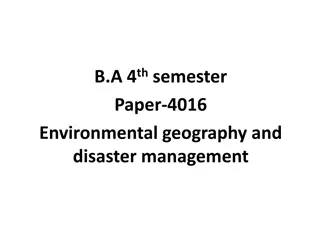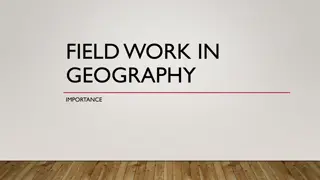Understanding Geographical Space in Geography Studies
Geographical space in geography encompasses natural and social elements, defining locations, and interactions essential for comprehending the world. Space and place influence various aspects such as economics, health, and climate. Geographers explore spatial distribution, processes, and human-environment interactions. Eratosthenes, an ancient Greek scholar, is regarded as the Father of Geography for his significant contributions. Geography branches into Physical, Human, and Regional Geography, all rooted in studying Earth's surface and spaces.
Download Presentation

Please find below an Image/Link to download the presentation.
The content on the website is provided AS IS for your information and personal use only. It may not be sold, licensed, or shared on other websites without obtaining consent from the author. Download presentation by click this link. If you encounter any issues during the download, it is possible that the publisher has removed the file from their server.
E N D
Presentation Transcript
GOVERNMENT COLLEGE FOR WOMEN (AUTONOMOUS) KUMBAKONAM DEPARTMENT OF GEOGRAPHY II MSc - Geography, Elective course (EC) REGIONAL PLANNING
MEANING OF GEOGRAPHIC SPACE Definition Definition: Geographic space is composed of Natural elements such as vegetation , soil, mountain, climate and bodies of water, as well as social and cultural elements, that is the economic and social organization of people and their values and customs.
Meaning of Space: What is geographic Space? What is geographic Space? Geographic space is a set of ordered locations. Location (topos) is one of Geographer s Geographic space is a set of ordered locations. Location (topos) is one of Geographer s fundamental concepts and is defined as a place, or action (or) process of placing someone or fundamental concepts and is defined as a place, or action (or) process of placing someone or something in a particular position. something in a particular position. Why Space is Important in Geography? Why Space is Important in Geography? The concepts of this and space and very important for understanding the function of The concepts of this and space and very important for understanding the function of phenomena in the natural world. Time is important to physical geography, because the spatial phenomena in the natural world. Time is important to physical geography, because the spatial pattern they study can often only be explained in historic terms, SPACE represents the real world pattern they study can often only be explained in historic terms, SPACE represents the real world or environment. or environment. The (EX) of space in geography a Space is a general objective location or area (EX) The (EX) of space in geography a Space is a general objective location or area (EX) DUSTIN DUSTIN is studying the Languages human speak, he might at America or he might compare is studying the Languages human speak, he might at America or he might compare residents of Taxes to residents of revels or Massachusetts. The U.S as well as the states of Texas, residents of Taxes to residents of revels or Massachusetts. The U.S as well as the states of Texas, Nevada and all are spaces. Nevada and all are spaces.
If Geography include Space? Geographers study the Space and the temporal database distribution of phenomena, processes and features as well as the interaction of humans and their Environment. Because Space and place affect a variety of topics, are economics, health, climate, plants, animals and human beings. Geography is highly interrelated to space. Who is Father of GEOGRAPHY? ERATOSTHENES, the ancient Greek scholar is called the Father of GEOGRAPHY . He was the first one to use the word geography and he also had a small-scale nation of the planet that helped him to determine the circumference of the Earth.
What are the Types of Geography? What are the Types of Geography? Geography is divided into Geography is divided into Physical Geography, Human Geography, Geographic Technique Physical Geography, Human Geography, Geographic Technique and and Regional Geography Regional Geography. So, all Geographic subjects basically depends upon from the Earth s Surface. We . So, all Geographic subjects basically depends upon from the Earth s Surface. We must known about the must known about the SPACE SPACE on the surface. on the surface. Major Types of Geography: Major Types of Geography: 2 2 Main Branches are Main Branches are Physical Physical Geography & Geography & Human Human Geography. Geography. Why Geography is a Spatial Science? Why Geography is a Spatial Science? Geography is described as a Geography is described as a Spatial Science Spatial Science because al it focuses is on because al it focuses is on Where Where things are and things are and why why they occur there. Geographers seek to answer all or more than one of four basic questions they occur there. Geographers seek to answer all or more than one of four basic questions when studying our environment. They relate to location, place, when studying our environment. They relate to location, place, Spatial Spatial pattern and pattern and Spatial Spatial distribution. distribution.
Important of Geographic Space and Regions: As a way of describing Spatial areas, the concepts of Regions is important and widely used among the many branches of Geography, each of which can describe areas in Regions. A Region has it s own nature that could not be moved. The first nature is it s natural environment (landform, Climate). Scope of Geographic Regions: Regional Geography is based on the Earth s Surface studies. It have lot of branches of sciences such as climatology, geomorphology, geology, biology, bio-geography, physical geography, environmental geography, botany, and zoology. Regional geography Explain where we living, why we living, the relationship between earth and man, space and the plants, animals and human being.
SCOPE OF GEOGRAPHIC SPACE AND REGIONS: Regional geography studies the specific unique characteristics of places related to their culture, economy, topography, climate, political and environmental factors such as their different species of flora and fauna. Also Regional geography studies the specific boundaries between places.
GROWTH POLE DEFINITION DEFINITION OF OF GROWTH GROWTH POLE POLE: : The development development or or growth place place around around a a specific The Central Central idea growth is is not specific pole(or idea of of the not uniform pole(or culture) the growth growth poles uniform over over an culture). . poles theory an entire entire region, theory is is that region, but that economic economic but instead instead takes takes What What is is Growth Growth Pole Pole and and growth growth Centre? Centre? Growth Growth pole Centre Centre or or Growth Centre Centre. . pole is is referred referred without Growth points points refer without any refer to to a a distinction distinction between any geographical geographical dimension, between growth dimension, but growth pole pole and but Growth Growth and Growth Growth
Propounded the concept of GROWTH POLE: The Growth Pole theory was developed by French regional economist, Francois Perroux, in 1955. He was concerned with the phenomenon of economic development and with the process of structural change. What is Growth Centre? Growth Centre may be defined as service (Rural/Urban) which has a potential for further development and hence need to be supported by further public. Regional Growth: Regional Growth defined as a land use planning policy document coordinated by a regional district for it s member municipalities. A number of regions in the province are beginning to better link land use decision making and economic development.
Meaning of QROWTH POLE The main author of growth poles theory, created in the 1950s, was Francois Perroux (1903 1987). The key and the most important theoretical foundation of the whole concept was Perroux s argument which explains the procedure of economic growth in the following way: "It is a blunt and indisputable fact that growth is not uniform in different places but growth has different degrees of intensity in different point, or poles, and then it spreads via channels and its final result for the state economy is different in different regions" (Vystoupil, 2003).
Growth poles theory thus documents the contribution of polarization to the development of poles as well as peripheries and this theory identifies 4 basic types of polarization (Adam k, 2002): Technological and technical - based on the concentration of new technology in the growth pole, Income - the growth pole contributes to the concentration and the growth of income due to expansion of services and dependence on demand and profit, Psychological based on the optimistic anticipation of future demand in the propelled region, Geographical based on the concentration of economic activity in a geographically determined space.
Development poles and growth centres as synthetically concepts : The concepts and theories of development poles and growth centres have quite recently been introduced in theories of development and regional and regional economics. The concepts employed somewhat ambiguous and still for being well established. The theory is basically in need of a thorough the economic development of regions.
Scope and Significance of Growth Pole and Growth Centre Theory Although originally the concepts of poles of growth were developed as a tool to study the anatomy of economic growth in abstract economic spaces, during time its scope has been con- side ably broadened so that it now can be said to be a synthetically concept oriented towards problems of socio-economic development. Growth pole. GROWTH POLE REFERS to the concentration of highly innovative and technically advanced industries thatstimulate economic development in linked businesses and industries. ... These concentrations of industries often affected the economies of geographical areas outside their immediate regions.
Importance of Ggrowth Pole and Growth Center Theory In recent years growth pole and growth center theory has been a major source of economic development planning strategy. The agglomeration factors of Webern industrial location can be traced back while analyzing the concept of the growth pole theory. Growth generally does not take place simultaneously at all places but is concentrated in few places. Such places are called growth poles and growth centers. The theory of growth pole and growth centers may be successfully applied to attain a balanced regional development.
REGIONAL DEVELOPMENT MODELS: GROWTH POLES AND INTEGRATED DEVELOPMENT The formulation of regional development strategy is a basic requirement for the successful implementation of regional programming. A constitutive element of this strategy is the selection of the spatial or regional development model. Internationally, there are two dominant models: the growth poles and diffusion model, and the model of integrated local - endogenous development. The first perspective refers to the attraction of activities and the concentration of growth in poles, from where the diffusion of growth is expected to occur towards the surrounding region (Perroux, 1955; Aydalot, 1965; Boudeville, 1968). The second model refers to the integrated spatial development, which is based on the utilisation of the endogenous potential of the regions (Coffey and Polese, 1985; Barquero, 1991; Garofoli, 2002). The strategy, that is based on the growth poles model, has ruled the field at an international level since
REGIONAL DEVELOPMENT: GROWTH POLES AND INTEGRATED DEVELOPMENT The formulation of regional development strategy is a basic requirement for the successful implementation of regional programming. A constitutive element of this strategy is the selection of the spatial or regional development model. Internationally, there are two dominant models: the growth poles and diffusion model, and the model of integrated local - endogenous development. The first perspective refers to the attraction of activities and the concentration of growth in poles, from where the diffusion of growth is expected to occur towards the surrounding region (Perroux, 1955; Aydalot, 1965; Boudeville, 1968). The growth pole model refers to the integrated spatial development, which is based on the utilisation of the endogenous potential of the regions.























